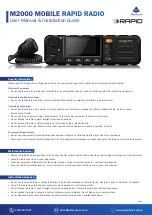
VHF 300 Series Owner’s Manual
Basic Operation
Switching Between 1 W and 25 W Transmitting Modes
You can control the transmitting power of the radio. There are two options: LO (1 W) and
HI (25 W). LO is typically used for local transmissions, while HI is typically used for
distance and distress transmissions.
NOTE:
When you press the
16/9
key (North American models) or the
16+
key
(International models), the radio switches to HI power. While in 16/9 mode, Channel 16
and the second-priority channel (Channel 9 by default) automatically transmit on HI power.
However, you can switch to LO power in 16/9 mode.
When two signals are broadcast on the same frequency, a VHF radio only receives the
stronger of the two signals. Other than distress calls, transmit using the lowest power
setting that allows you to communicate. This reduces the possibility of your transmissions
interfering with the transmissions of disinterested parties.
In the USA frequency band, transmissions on Channels 13 and 67 are required to be low-
power (1 watt) by default. You can bypass this power setting by pressing the
25W
soft key
during transmission.
To switch between LO and HI transmitting power:
1. Press the
HI/LO
key.
2. Select
1W
or
25W
to toggle between LO and HI transmit power modes.
TIP:
The radio returns to the Home screen automatically two seconds after changing the
1 W/25 W mode. You can also select
OK
to return to the Home screen.
Adjusting the Local/Distant Receiving Sensitivity
You can control the receiving sensitivity of the radio. If you are experiencing noise in high-
traffic areas or areas with electromagnetic interference (caused by cell-phone towers, for
example), set the receiving sensitivity to Local to decrease the sensitivity of the receiver. In
remote areas and in open water, set the receiving sensitivity to Distant to ensure that you are
using the maximum range of the receiver.
The
LOC
icon is displayed on the screen when set to Local receiving sensitivity.
1. Press the
HI/LO
key.
2. Select
LOCAL/DIST
to toggle between local and distant modes.















































